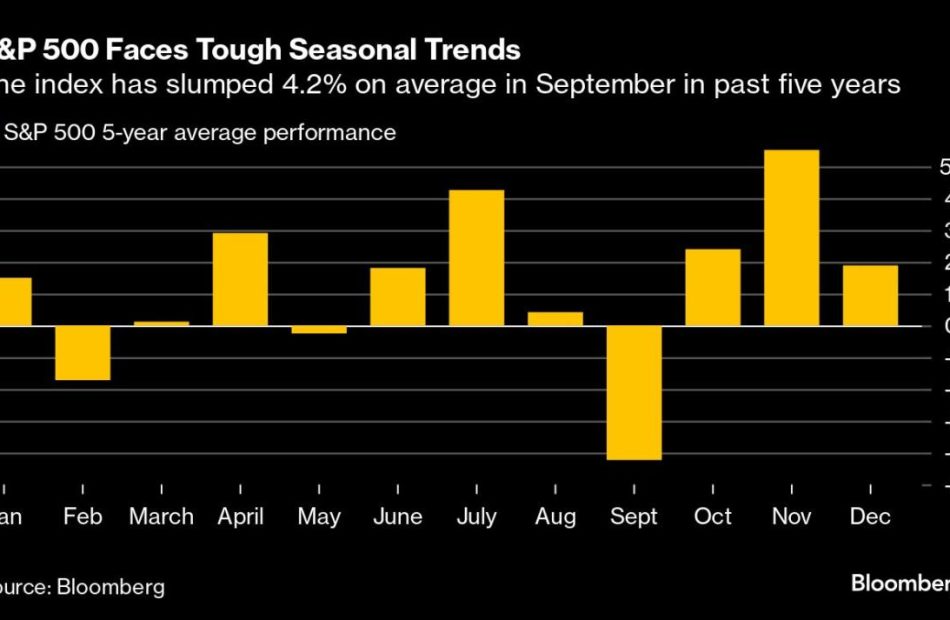JPMorgan’s Matejka Says Stocks Risk Stalling Even With Rate Cut
(Bloomberg) — The equity market rally may stall near record highs even if the Federal Reserve starts a highly anticipated rate-cutting cycle, according to JPMorgan Chase & Co. strategists.
Most Read from Bloomberg
The team led by Mislav Matejka — who has been among the most bearish voices on stocks this year — said that any policy easing would be in response to slowing growth, making it a “reactive” reduction. The seasonal trend is another impediment, with September historically the worst month for US stocks.
“We are not out of the woods yet,” Matejka wrote in a note, reiterating his preference for defensive sectors against the backdrop of a pullback in bond yields. “Sentiment and positioning indicators look far from attractive, political and geopolitical uncertainty is elevated, and seasonals are more challenging again in September.”
After slumping in the early days of August, the S&P 500 recovered to end the month within striking distance of a record high on bets that the Fed will start cutting interest rates at its next policy meeting on Sept. 17-18. The MSCI All-Country World Index is at an all-time peak.
The US benchmark has declined 4.2% on average in September in the past five years, according to data compiled by Bloomberg. Traders are also awaiting a raft of economic data, including the all-important jobs report this week, for more clues on the health of the economy.
S&P 500 futures declined 0.4%. The stock market is closed for a holiday on Monday.
Other market strategists including Bank of America Corp.’s Michael Hartnett have recently warned that the Fed’s first rate cut would be a catalyst to sell equities rather than drive another leg higher.
–With assistance from Kit Rees.
(Adds move in US stock futures in sixth paragraph. A previous version corrected the timing of jobs report.)
Most Read from Bloomberg Businessweek
©2024 Bloomberg L.P.
4 Reasons to Buy Walmart Stock Like There's No Tomorrow
Are you considering taking on a new stake in Walmart (NYSE: WMT) but are intimidated by the stock’s recent run-up to record highs? It’s not an unreasonable concern. It’s almost always better to buy good stocks at a discount rather than a premium if you can.
This is one of these cases, however, where waiting for a better price could end up costing you more than it saves. Walmart shares are marching forward because the retailer is firing on all cylinders, and that’s not likely to stop anytime soon.
If you’re wondering specifically why the world’s biggest retailer makes for such a great investment right now, though, here are the top four reasons.
1. Walmart’s sheer size is a distinct competitive advantage
You probably already know Walmart is the world’s biggest brick-and-mortar retailer. What you may not fully appreciate is just how much bigger it is. For perspective, this company operates over 10,600 stores all over the world, with more than half of them located outside of the United States. Its next-nearest competitor is Kroger with its 2,750 locales, while there are just under 2,000 Target stores.
Said another way, as big as e-commerce behemoth Amazon is, in terms of revenue, Walmart is still bigger.
Size isn’t necessarily everything, of course. After all, big companies can be run badly too! Walmart is run very, very well, however, using its size and subsequent spending power to keep competitors in check by doing things those competitors simply can’t afford to do.
2. The retailer’s revenue “ecosystem” approach is working
You’re likely familiar with the term “omnichannel,” but if not, it’s just a term used to describe how retailers meld their online and in-store shopping environment into a seamless experience for consumers. It’s a phrase, however, that no longer accurately describes how smarter retailers like Walmart engage with shoppers. Increasingly, the industry creating new ways for consumers to purchase goods without even thinking about it; shopping with a particular store chain simply becomes part of a lifestyle.
Yes, Walmart’s subscription-based Walmart+ program is an example of this lifestyle ecosystem. Although the company didn’t cite a specific headcount, it did report double-digit percentage growth in the number of paying members, leading to 14.4% year-over-year growth in its membership income. And, given that Walmart+ members enjoy free shipping and delivery, it makes sense that last quarter’s 22% year-over-year growth in e-commerce revenue was largely driven by this convenience-seeking crowd.
It’s not just a matter of offering more convenience, though. Walmart monetizes its ecosystem in other ways, too. For instance, the company now allows its vendors and suppliers to pay to promote their goods being sold via Walmart.com. This advertising business’s high-margin revenue was up 26% year over year last quarter and higher by 30% in the United States. The retailer also recently launched an effort to acquire television brand Vizio, which presents another platform from which to directly engage with — and advertise to — consumers. As of the most recent count, Vizio reported over 18 million active accounts/users of its television. It’s going to be interesting to see all the different ways Walmart will wind up engaging with them.
Its enormous brick-and-mortar presence, of course, bolsters the usage of its online and out-of-store offerings.
3. Walmart is (finally) appealing to upper-income households
Prior to the COVID-19 pandemic, affluent households weren’t exactly regular Walmart shoppers. Then, practicality set in. Once inflation began soaring in 2021, even households earning in excess of $100,000 per year were forced to start thinking about their budgets. Not only was Walmart more likely to offer what these consumers needed, it was more likely to offer it at a better price. For the next couple of years, the retailer regularly touted market share gains among this demographic.
Inflation is finally abating, however, leaving investors wondering if these newly won customers will continue shopping with the discounter.
Some won’t, to be sure. But, given all that Walmart is doing to keep this crowd around, many of them likely will.
Take the company’s overhaul of the in-store presentation of some of its apparel lines as an example. For decades its sales floors looked more like warehouses than a department store. Not anymore though. Seasonal and theme-based visual presentations (dressed mannequins, entire room setups on risers, branding backdrops, etc.) are now the norm, nodding back to traditional department stores’ glory days by featuring in-demand brands and goods.
It’s not just more compelling in-store presentations either. The retailer is adding higher-end brands to the mix as well. Reebok and Chaps are both recent premium additions to the chain’s apparel lines, for instance. Premium wines are another once-unlikely addition to its store shelves that appeal to the higher-end crowd.
4. Walmart is resilient regardless of the economic backdrop
Walmart’s business is well protected no matter what sort of economic environment we’re in. Granted, that’s largely because over half of its revenue is grocery-related. People must eat regardless of the cost of doing so, after all.
Even taking the must-have nature of the majority of Walmart’s revenue out of the discussion, though, the retailer can still hold up to challenges. More than 10% of its top line comes from health and wellness products, and while roughly 25% of its sales comes from general merchandise that in theory could be economically sensitive, consumers will always need basics likes socks, office supplies, towels, kids’ clothes, light bulbs, and the like. No other retailer is beating Walmart’s prices on such items.
Or, think about it like this. Not once since 2017 has Walmart failed to produce quarterly revenue that was better than the year-ago comparison. That includes in late 2021 and early 2022 when the world was easing out of the pandemic which generated incredibly strong sales growth for the company just a year earlier.
Just keep it all in perspective
To be clear, investors shouldn’t expect too much. Walmart will never be a high-growth stock like, say, Nvidia or Alphabet. Last quarter’s top-line growth of just under 5% is in line with the company’s likely long-term norm. There’s only so much money consumers are willing and able to spend no matter how strong or weak the economy is, just as there are only so many places Walmart can profitably establish a store.
On the flipside, don’t talk yourself out of a solid investment simply because Walmart stock is up as much as it is right now, or because the company itself lacks pizzazz. You don’t invest for excitement. You invest for plausible growth. To the extent every portfolio needs some stability and predictability, this name offers plenty of both, and will likely continue doing so well into the future.
Should you invest $1,000 in Walmart right now?
Before you buy stock in Walmart, consider this:
The Motley Fool Stock Advisor analyst team just identified what they believe are the 10 best stocks for investors to buy now… and Walmart wasn’t one of them. The 10 stocks that made the cut could produce monster returns in the coming years.
Consider when Nvidia made this list on April 15, 2005… if you invested $1,000 at the time of our recommendation, you’d have $731,449!*
Stock Advisor provides investors with an easy-to-follow blueprint for success, including guidance on building a portfolio, regular updates from analysts, and two new stock picks each month. The Stock Advisor service has more than quadrupled the return of S&P 500 since 2002*.
*Stock Advisor returns as of August 26, 2024
Suzanne Frey, an executive at Alphabet, is a member of The Motley Fool’s board of directors. John Mackey, former CEO of Whole Foods Market, an Amazon subsidiary, is a member of The Motley Fool’s board of directors. James Brumley has positions in Alphabet. The Motley Fool has positions in and recommends Alphabet, Amazon, Nvidia, Target, and Walmart. The Motley Fool recommends Kroger. The Motley Fool has a disclosure policy.
4 Reasons to Buy Walmart Stock Like There’s No Tomorrow was originally published by The Motley Fool
A Billionaire-Led Hedge Fund Is Gobbling Up This Speculative Artificial Intelligence Stock. Should You?
Billionaire stock portfolios can unearth top investment ideas. Most billionaire investors, after all, have superb track records when picking equities.
Point72, a global asset manager led by billionaire Steven A. Cohen, has been steadily buying shares of gallium nitride (GaN) power integrated circuit specialist Navitas Semiconductor Company (NASDAQ: NVTS) since the first quarter of 2023.
After adding another 4.12 million shares in the second quarter of 2024, Point72 now owns a 2.34% stake in the next-generation semiconductor company. This investment is intriguing for several reasons.
First, Navitas shares trade at a mere $3.02 per share, a price point that typically keeps professional investors on the sidelines. Next, the semiconductor company isn’t in the best financial shape either. More on that in a moment.
Yet Cohen’s aggressive buying over the past year and a half warrants attention by investors on the hunt for the next big growth play. Let’s dig deeper to better understand Navitas’ core value proposition and risk profile.
Navitas: A next-generation semiconductor player
Navitas designs, develops, and markets gallium nitride power integrated circuits, silicon carbide, and associated components used in power conversion and charging. Its products find applications in mobile devices, consumer electronics, data centers, solar inverters, and electric vehicles (EVs). The company operates globally, with its principal executive offices in Torrance, California.
Founded in 2013, Navitas is pioneering the GaN market with a proprietary GaN power IC platform shipping in mass production to tier-1 companies like Samsung, Dell, Lenovo, and Amazon. The company’s solutions offer faster charging, higher power density, and greater energy savings compared to silicon-based power systems.
Core strengths and market opportunities
Navitas’ core strength lies in its industry-leading IP position, including a comprehensive patent portfolio and proprietary process design kit (PDK). The company’s research and development activities, primarily located in the U.S. and China, consumed approximately 90% of its revenue in the first half of 2024.
The company is targeting several high-growth markets. In the Enterprise/AI Data Center segment, Navitas is developing AC-DC power platforms up to 10 kW to meet Nvidia‘s demanding Hopper-Blackwell-Rubin roadmap. The EV/eMobility division is seeing strong growth in its customer pipeline, with over 200 projects in development.
The Appliance/Industrial segment is poised for a revenue ramp in 2025 across diverse applications. In the Solar/Energy Storage market, Navitas is displacing legacy silicon chips with both SiC and GaN technologies, according to its latest 10-Q.
The gallium nitride market: Heating up for future demand
The power gallium nitride device market is projected to grow significantly in the coming years. This market is set to expand from $126 million in 2021 to $2 billion in 2027, representing a compound annual growth rate of 59%, according to market research firm Yole Développement. This parabolic growth is primarily driven by increasing demand in consumer electronics, data centers, and electric vehicles.
However, the robotics revolution could serve as a future catalyst for even more explosive growth in the GaN market. Artificial intelligence (AI) is expected to power advanced robotics from 2025 to 2035, potentially unlocking trillions in economic value. While this isn’t the primary driver of current GaN market growth, it represents a significant future opportunity that could sustain and potentially accelerate the market’s expansion.
Navitas’ technology could play a crucial role in addressing the power consumption challenges that currently hold back the robotics field. As robots become more integrated into daily life, they will require access to rapid recharging systems that can meet their enormous power requirements. Navitas appears to have intellectual property rights to technology that could address this critical need, positioning the company to potentially capitalize on this future demand.
Financial challenges and risks
However, Navitas faces significant financial challenges. As of June 30, 2024, the company had $112.0 million in cash and cash equivalents. Its GAAP loss from operations for the most recent quarter was $31.1 million. Over the past five years, Navitas’ number of outstanding shares has also increased substantially due to dilution, while its share price has declined sharply.
Barring a sudden revenue uptick, possibly from its data center business, this trend may continue. While sales are growing by double-digits, Navitas is only expected to generate around $148 million in revenue in 2025, according to Wall Street’s most optimistic forecast. The company is also projected to remain cash flow negative next year, potentially straining its remaining cash reserves.
Is this speculative AI stock a buy?
Steven Cohen’s hedge fund seems to be positioning itself ahead of a potential shift in the semiconductor industry from traditional silicon-based chips to GaN semiconductors. Navitas, as a leader in this niche, could benefit enormously from this trend. Its shares also offer exposure to the coming robotics revolution.
However, investors should carefully weigh the company’s growth potential against its financial risks before following in Cohen’s footsteps. Navitas is far from a slam dunk and serious challenges lie in its path to success.
What’s the bottom line? This AI stock screens as a potential buy for aggressive investors with a high tolerance for risk. That being said, Navitas probably shouldn’t account for more than 1% of your stock portfolio at this early juncture, and investors will want to keep a close eye on the company’s progress.
Should you invest $1,000 in Navitas Semiconductor right now?
Before you buy stock in Navitas Semiconductor, consider this:
The Motley Fool Stock Advisor analyst team just identified what they believe are the 10 best stocks for investors to buy now… and Navitas Semiconductor wasn’t one of them. The 10 stocks that made the cut could produce monster returns in the coming years.
Consider when Nvidia made this list on April 15, 2005… if you invested $1,000 at the time of our recommendation, you’d have $731,449!*
Stock Advisor provides investors with an easy-to-follow blueprint for success, including guidance on building a portfolio, regular updates from analysts, and two new stock picks each month. The Stock Advisor service has more than quadrupled the return of S&P 500 since 2002*.
*Stock Advisor returns as of August 26, 2024
John Mackey, former CEO of Whole Foods Market, an Amazon subsidiary, is a member of The Motley Fool’s board of directors. George Budwell has no position in any of the stocks mentioned. The Motley Fool has positions in and recommends Amazon and Nvidia. The Motley Fool has a disclosure policy.
A Billionaire-Led Hedge Fund Is Gobbling Up This Speculative Artificial Intelligence Stock. Should You? was originally published by The Motley Fool
This Ultra High-Yield Dividend Stock Just Raised Its Payout. Should You Buy?
Among ultra-high-yield dividend stocks of long standing, you don’t get much more reliable than Altria Group (NYSE: MO). The company has consistently paid a generous dividend, and its stock is one of the market’s rare Dividend Kings, meaning its management has enacted dividend raises at least once annually for at least 50 years in a row.
Sure enough, like clockwork, Altria made its habitual once-per-year dividend raise this summer. Here’s a look at the particulars of the hike and whether it helps make the cigarette giant’s stock worth owning.
A king in its industry
In mid-August, Altria declared its latest dividend raise. It decided to lift the quarterly payout by 4% to $1.02 per share, which pumps the forward yield up to 7.7% on the most recent closing stock price. The first distribution of the raised amount will occur on Oct. 10 to investors of record as of Sept. 16. So, there’s still time for dedicated income stock fans to take advantage of the hike.
But should they? I’ve been convinced for some time now that Altria stock isn’t a long-term winner, no matter how sky-high the yield — and its dividend is up there for sure, paying several times the 1.3% average yield of S&P 500 index component stocks.
Altria’s big problem is the continued and serious decline of the traditional cigarette market. With increasing general health awareness and anti-smoking campaigns from influential entities, such as the federal government, much of the American public has eschewed ciggies. From 2001 to 2021, hardly an epic stretch of time, the number of cigarettes sold in the U.S. declined by more than half to just over 190 billion in the latter year, according to data compiled by Statista.
Understandably, Altria is attempting to pivot to what it calls “a smoke-free future.” This will be anchored by NJOY, the e-cigarette brand it acquired in June 2023 for a cool $2.75 billion in cash following the debacle that was its investment in troubled brand JUUL. The company was quick to point out in its latest quarterly earnings report that its shipment volumes for NJOY devices increased 80% quarter over quarter to 1.8 million units, and the brand’s market share rose by 1.3 percentage points to 5.5%.
That’s impressive up to a point, but then again, NJOY is a relatively new brand for Altria, and its mass rollout in this country began only recently. It feels, then, that those hefty shipment numbers derive from a relatively low base. And while vaping has been a growing trend, it might not be the savior of the cigarette industry. Again, according to Statista, the estimated compound annual growth rate (CAGR) for e-cigarette revenue from 2024 to 2029 is 5.8%.
That certainly isn’t a bad figure, but probably not enough of a rise to offset the apparently eternal decline in traditional cigarette sales. Altria’s second-quarter net revenue fell by nearly 5% year over year, largely because of this.
Of yield hunters and yield traps
Most investors who consider loading up on Altria or its publicly traded peers, like Philip Morris International and British American Tobacco (BAT), are well aware of the challenges the industry faces. Still, they’ve lately piled into all three companies, as the trio has notably outperformed the S&P 500 index year to date.
I think much of this popularity is due to yield; the three stocks all boast high figures, with Altria’s theoretical 7.7% being beaten only slightly by BAT’s 8%. Philip Morris is a laggard among the three but still delivers an appealing 4.3% on its payout.
Yield chasing is in fashion these days, particularly with Federal Reserve (Fed) Chair Jerome Powell’s near-direct pledge recently to cut the regulator’s key interest rate in the near future. Since this rate is a reference point for nearly any financial asset, investor payouts, like bond coupons, tend to drop when rates dip. So, it’s little wonder that some market players are eager to get their hands on stocks with reliably high payouts.
In my view, this has left the share prices of the tobacco merchants inflated. It only compounds the secular decline in what is still very much their core business. I don’t feel these price increases are sustainable, and the industry as a whole is set for a correction. Meanwhile, the ciggie merchants aren’t the only high-yield dividend stocks in town, far from it. We need only to glance at the real estate investment trust (REIT) industry, to name one example, to find sturdy companies with generous distributions.
It’s always tempting to jump into a company that has declared a dividend raise, particularly if it’s raising an already ultra-high-yield dividend. Yet, I think Altria qualifies as a yield trap these days. I wouldn’t be a buyer of the stock, particularly for the long term.
Should you invest $1,000 in Altria Group right now?
Before you buy stock in Altria Group, consider this:
The Motley Fool Stock Advisor analyst team just identified what they believe are the 10 best stocks for investors to buy now… and Altria Group wasn’t one of them. The 10 stocks that made the cut could produce monster returns in the coming years.
Consider when Nvidia made this list on April 15, 2005… if you invested $1,000 at the time of our recommendation, you’d have $731,449!*
Stock Advisor provides investors with an easy-to-follow blueprint for success, including guidance on building a portfolio, regular updates from analysts, and two new stock picks each month. The Stock Advisor service has more than quadrupled the return of S&P 500 since 2002*.
*Stock Advisor returns as of August 26, 2024
Eric Volkman has no position in any of the stocks mentioned. The Motley Fool recommends British American Tobacco P.l.c. and Philip Morris International and recommends the following options: long January 2026 $40 calls on British American Tobacco and short January 2026 $40 puts on British American Tobacco. The Motley Fool has a disclosure policy.
This Ultra High-Yield Dividend Stock Just Raised Its Payout. Should You Buy? was originally published by The Motley Fool
Down 86%, Is It Time to Buy the Dip on This Growth Stock?
Roku (NASDAQ: ROKU) is another perfect example of a pandemic-era darling that has fallen from grace. Shares skyrocketed 530% from their March 2020 low to their all-time high in July 2021, driven by monster success fueled by consumers spending more time at home.
However, the shares now trade 86% below that peak price. So, is it time to buy the dip on this growth stock?
Riding the streaming wave
Part of the reason Roku’s stock has been under pressure in recent years is because of slowing growth. Revenue jumped more than 55% in both 2020 and 2021. As consumer behavior normalized, those gains weren’t as impressive.
But the situation is not as bad as the stock’s performance would suggest. Roku posted a 14% revenue gain in the latest quarter, with management forecasting an 11% rise in the third quarter. The business is still expanding at a healthy pace.
The company added 2 million active accounts in Q2, bringing the total to 83.6 million. Roku has top-market share among providers of smart-TV operating systems not only in the U.S. but also in Canada and Mexico. And engagement is through the roof, as a whopping 30.1 billion hours of content were streaming in the last three-month period. This means that each account on average spends four hours per day on Roku.
Roku prides itself on being an agnostic platform that plays ball with all the content companies out there. Consequently, the business is in a favorable position to gain from the ongoing cord-cutting trend. Another benefit is that it doesn’t have to shell out billions of dollars each year to license and produce content. As more consumers ditch their cable subscriptions, Roku will undoubtedly be a top choice to aggregate the numerous services out there into a single-user interface.
Investors might not like the cyclicality of the digital-ad industry. In softer economic periods, marketing executives pull back spending. This is exactly what happened in 2022 and 2023. Over the long term, though, it’s inevitable that ad dollars will flow to streaming services because that’s where the eyeballs are. This should play to Roku’s favor.
Risk and valuation
Roku might be the leading-streaming platform. However, the business isn’t without some notable risks that investors should know about.
For starters, the company isn’t generating positive-net income. Management boasts that the business has reported positive-adjusted earnings before interest, taxes, depreciation, and amortization (EBITDA) in four straight quarters, with the expectation that this will continue going forward. But that figure not only excludes key expenses, but it can be manipulated to make things look good.
The fact that Roku isn’t yet profitable on a generally accepted accounting principles (GAAP) basis means that the business model hasn’t yet proven that it’s financially sustainable.
Roku has grown its revenue, user base, and engagement over the years on the backs of the streaming-secular trend. But by keeping a critical eye on the company’s industry positioning, there is one thing to keep in mind.
A valid argument can be made that Roku is at the mercy of the major content companies. For example, I’d suspect that Netflix or Alphabet‘s YouTube share none or very little ad inventory with Roku. And Roku needs these two businesses to cooperate more than the other way around. This tells me that the content publishers have the negotiating leverage.
Investors need to be aware of these risks. But given that the stock trades at a price-to-sales ratio of 2.6, which is substantially below its historical average of 9.5, the valuation is compelling enough to buy the dip on this growth stock.
Should you invest $1,000 in Roku right now?
Before you buy stock in Roku, consider this:
The Motley Fool Stock Advisor analyst team just identified what they believe are the 10 best stocks for investors to buy now… and Roku wasn’t one of them. The 10 stocks that made the cut could produce monster returns in the coming years.
Consider when Nvidia made this list on April 15, 2005… if you invested $1,000 at the time of our recommendation, you’d have $731,449!*
Stock Advisor provides investors with an easy-to-follow blueprint for success, including guidance on building a portfolio, regular updates from analysts, and two new stock picks each month. The Stock Advisor service has more than quadrupled the return of S&P 500 since 2002*.
*Stock Advisor returns as of August 26, 2024
Suzanne Frey, an executive at Alphabet, is a member of The Motley Fool’s board of directors. Neil Patel and his clients have no position in any of the stocks mentioned. The Motley Fool has positions in and recommends Alphabet, Netflix, and Roku. The Motley Fool has a disclosure policy.
Down 86%, Is It Time to Buy the Dip on This Growth Stock? was originally published by The Motley Fool
Is This 1 Thing the Biggest Risk for Airbnb Stock?
Despite being around for less than two decades, Airbnb (NASDAQ: ABNB) has sure experienced monster success throughout its history. The alternative accommodations platform has truly upended the hospitality industry. And its scale is unmatched, with $21 billion in gross booking value just in the last quarter, as well as 5 million hosts on the site.
With the growth tech stock trading 46% below its all-time high, investors might want to buy the dip with Airbnb. Before doing so, it’s worth taking the time to understand what might be the company’s biggest risk.
Ongoing headaches
Airbnb has found tremendous success, but to be clear, it still operates in a competitive sector of the economy. There’s competition from global hotel chains, boutique properties, and other booking platforms.
However, I think its biggest headache has been the regulatory landscape. There are varying rules that Airbnb must follow on a local, state, and federal level. It can be challenging to navigate all of this. The advent of the internet and these platform business models is making it difficult for lawmakers to keep up. So, there has definitely been some uncertainty for Airbnb.
The business has a big bullseye on its back because of how it can have a profound impact on the markets that it operates in, which can cause local residents to push back. For example, a higher number of listed properties could result in the constant influx of travelers, making a neighborhood feel more like a tourist destination than a real community. There could also be safety concerns.
Potential impacts to the cost of living can’t be ignored, either. Buyers could be drawn to a market due to attractive demographics, leading to home values going up. Moreover, these properties become a financial asset as opposed to a place for the owner to actually live in. This could exacerbate the problem of housing affordability in the U.S.
For what it’s worth, there are already regulations in place in 80% of the company’s top 200 markets, which does reduce the uncertainty somewhat. However, that doesn’t mean Airbnb is out of the woods. About a year ago, New York City banned rentals of less than 30 days. Any other adverse legislative actions taken in key markets could negatively impact the business.
Founder and CEO Brian Chesky and his team don’t agree with the move. They say that hosts pay their taxes and bring in tourism and spending that can enhance an economy. And a valid argument can be made that if Airbnb were charged higher fees or fines were imposed, the experience for both hosts and guests could be diminished.
Of the more than 100,000 cities and towns Airbnb has active listings in, not a single one accounts for more than 2% of the company’s revenue. That geographic diversity helps to mitigate regulatory risk at least at the local level.
Should you buy Airbnb stock?
Investors looking to buy Airbnb stock need to understand that regulatory actions pose a threat to the company’s trajectory. I still believe the shares are a worthy investment candidate, though.
Airbnb’s growth is still healthy, even though it is slowing down. Sales increased 11% from under $2.5 billion in the second quarter last year to over $2.7 billion in Q2 this year.
Airbnb generates robust profitability. Free cash flow totaled $4.3 billion in the last 12 months, which represented 41% of overall business revenue.
And the company’s two-sided marketplace creates network effects. The larger the platform becomes, with more hosts and guests, the more valuable it becomes to everyone.
All of these positive attributes should mean the stock deserves a closer look.
Should you invest $1,000 in Airbnb right now?
Before you buy stock in Airbnb, consider this:
The Motley Fool Stock Advisor analyst team just identified what they believe are the 10 best stocks for investors to buy now… and Airbnb wasn’t one of them. The 10 stocks that made the cut could produce monster returns in the coming years.
Consider when Nvidia made this list on April 15, 2005… if you invested $1,000 at the time of our recommendation, you’d have $731,449!*
Stock Advisor provides investors with an easy-to-follow blueprint for success, including guidance on building a portfolio, regular updates from analysts, and two new stock picks each month. The Stock Advisor service has more than quadrupled the return of S&P 500 since 2002*.
*Stock Advisor returns as of August 26, 2024
Neil Patel and his clients have no position in any of the stocks mentioned. The Motley Fool has positions in and recommends Airbnb. The Motley Fool has a disclosure policy.
Is This 1 Thing the Biggest Risk for Airbnb Stock? was originally published by The Motley Fool
1 Top Space Stock You Need to Know About Before a Key Launch in September
Long-term investors shouldn’t make decisions about buying or selling a stock based on a single event. Data from a quarterly earnings report, for example, should be monitored, reviewed, and added to an investor’s mental database. But a quarterly report is just a single snapshot of the company’s business.
Yet in the case of AST SpaceMobile (NASDAQ: ASTS), there is one upcoming event to which investors looking for a growth opportunity should be paying especially close attention. The company is getting ready to launch its first set of commercial broadband satellites. Those five satellites represent the commercial start to what could become one of the largest global telecom companies over the coming years.
Untapped potential for space-based mobile connectivity
AST’s patented technology will supply cellular providers around the world with broadband internet access to connect those without internet service. The market for that could be huge. AST estimates that worldwide, as of the end of 2022, there were 5.5 billion cellular subscribers, and as many as 3.5 billion of them were not subscribed to cellular broadband. The opportunity this offers helps explain why the stock has exploded by about 600% over the last 12 months.
Importantly, AST SpaceMobile is building the first and only global, space-based cellular broadband network to operate directly with mobile devices. It aims to connect standard mobile phones directly to satellites, bypassing the need for ground infrastructure like cell towers. The satellite network could improve connectivity to the billions of existing mobile subscribers in addition to offering service to those who are currently unconnected.
AST SpaceMobile’s service also differentiates itself from SpaceX’s Starlink because it would connect directly to typical smartphones without any additional hardware. Existing mobile devices will be all that users need. Starlink requires users to have a satellite dish for connectivity. That dish must be purchased, then set up and pointed toward the satellites to access the internet.
Sept. 11 launch window
Somewhat ironically, while SpaceX’s Starlink service will compete with AST, a SpaceX Falcon 9 rocket is currently scheduled to launch AST’s first five BlueBird satellites during a launch window that begins Sept. 11.
That launch also highlights the complex relationships among companies and regulatory bodies in the evolving space sector. In May, AST announced a new commercial agreement with AT&T to provide its space-based broadband network directly to existing cellphones. AT&T Chief Operating Officer Jeff McElfresh explained the relationship this way:
Space-based direct-to-mobile technology is designed to provide customers connectivity by complementing and integrating with our existing mobile network. This agreement is the next step in our industry leadership to use emerging satellite technologies to provide services to consumers and in locations where connectivity was not previously feasible.
Mobile network operators like AT&T and Verizon Communications will be both competitors to and partners with AST SpaceMobile. Those network operators spend more than $300 billion in capital expenditures and nearly $70 billion for cell tower leases annually, according to a report by Scotiabank. That consumes an enormous amount of free cash flow, giving those companies a good reason to partner with AST for its planned global satellite constellation.
Early for valuation estimates
As is the case with other companies that are attempting to commercialize emerging technologies, it is difficult to properly value AST SpaceMobile at this early stage. Its market cap recently stood at about $7.5 billion. The network operator spending noted above dwarfs that value.
The opportunity to enhance mobile network operators’ coverage for typical smartphone users and for potential government contracts is vast. But there are plenty of hurdles to overcome. That includes getting through the initial BlueBird launch successfully.
Any issue with this launch might negatively impact AST’s share price in the short term. Regulatory issues will also need to be navigated, as governments need to ensure that different satellite operators’ networks can coexist without causing harmful interference to each other.
But AST SpaceMobile has enormous potential. Even with SpaceX’s Starlink well ahead in terms of the number of satellites it has in orbit, there are separate markets to be tapped by AST. Starlink largely targets broadband internet users in remote or rural areas. AST will focus on mobile connectivity for the billions of current and potential cellphone users.
That makes the stock a worthwhile speculative investment for aggressive investors. Given that its thesis has so many moving parts, the stock is a good candidate for a cautious buying strategy; I’d suggest those who want to should ease into their full position by buying in thirds. The most notable of those variables is the upcoming scheduled launch. For those interested in this space sector growth stock, that BlueBird launch will be well worth monitoring.
Should you invest $1,000 in AST SpaceMobile right now?
Before you buy stock in AST SpaceMobile, consider this:
The Motley Fool Stock Advisor analyst team just identified what they believe are the 10 best stocks for investors to buy now… and AST SpaceMobile wasn’t one of them. The 10 stocks that made the cut could produce monster returns in the coming years.
Consider when Nvidia made this list on April 15, 2005… if you invested $1,000 at the time of our recommendation, you’d have $731,449!*
Stock Advisor provides investors with an easy-to-follow blueprint for success, including guidance on building a portfolio, regular updates from analysts, and two new stock picks each month. The Stock Advisor service has more than quadrupled the return of S&P 500 since 2002*.
*Stock Advisor returns as of August 26, 2024
Howard Smith has positions in AT&T. The Motley Fool recommends Verizon Communications. The Motley Fool has a disclosure policy.
1 Top Space Stock You Need to Know About Before a Key Launch in September was originally published by The Motley Fool
GOTS combatting greenwashing with #BehindTheSeams campaign that educates consumers about sustainable textiles
Stuttgart, Germany, Sept. 02, 2024 (GLOBE NEWSWIRE) — For the second year running, Global Standard is taking consumers #BehindTheSeams this September, highlighting the sustainable and social qualities of GOTS-certified products – from runway fashion to hygiene products and so much more in between. Building on the success of last year, #BehindTheSeams 2024 has expanded to take over the entire month with more education on the people and practices making sustainable textiles, plus giveaways planned each day.
Global Organic Textile Standard (GOTS) is recognised for its comprehensive approach to sustainability. From promoting human rights along the value chain to banning harmful chemicals in certified textiles, GOTS sets a benchmark for integrity and sustainability. This campaign gives certified companies the opportunity to emphasise how they are at the forefront of changing the textile industry, and how adherence to GOTS is better for the environment more socially conscious throughout their textile production value chain.
Throughout September, Global Standard is excited to introduce daily giveaways on Instagram, featuring partnerships with leading GOTS-certified brands such as Frugi, FC St. Pauli, LangerChen, Natracare, Organic Basics, Mandala, Dedicated and more. Additionally, two major giveaways will be hosted on behindtheseams.eco, where visitors can learn about sustainability by answering daily questions and earning entries. One lucky person based in Europe and their guest will win a sustainable trip for two to Paris. This includes train travel, a two-night stay at the eco-friendly Eden Lodge Paris and a private fitting for a custom GOTS-certified jacket by John Preston. The winner will also enjoy dinner at La Table de Colette, a Michelin-starred restaurant committed to eco-responsibility, including a menu highlighting the carbon footprint of each dish. A lucky winner based in North America will win a hand-built GOTS-certified organic “Serenade” mattress sponsored by Naturepedic.
#BehindTheSeams is also spotlighting “organic in-conversion” farming and urging brands to support farmers during the critical transition period from conventional to organic. In this campaign, GOTS has partnered with the Organic Cotton Accelerator, a multi-stakeholder organisation dedicated to supporting farmers throughout the cotton supply chain as they make the shift to and sustain organic practices. Together, GOTS and OCA want to send a message that brands can bolster the organic cotton supply by investing in and buying organic in-conversion cotton.
“Global Standard and GOTS-certified companies work hard in the background to ensure a more organic, sustainable and socially conscious textile industry, but the consumer doesn’t always see or know what that actually means when they pick up a GOTS item in a store,” said Holger Stripf, head of marketing at Global Standard. “This campaign is a fun, engaging way to educate the public on living eco-consciously and why choosing organic textiles is better for the health of humans and the planet.”
Learn more at behindtheseams.eco.
日本語のプレスリリースはこちらをご覧ください。(Press release in Japanese)
请在此阅读中文新闻稿。(Press release in Chinese)
###
About Global Organic Textile Standard
GOTS (Global Organic Textile Standard), managed by non-profit Global Standard, is the world’s leading standard for organic textile certification. It sets strict environmental and social criteria for the entire textile value chain, from the harvesting of raw materials to the finished product. GOTS certification ensures the integrity of finished organic textiles and provides comprehensive solutions for the industry and assurance to consumers worldwide. For more information, visit www.global-standard.org.

Katie Lee Global Standard gGmbH lee@global-standard.org
Market News and Data brought to you by Benzinga APIs
© 2024 Benzinga.com. Benzinga does not provide investment advice. All rights reserved.
US Economy Roars In Q2, Dow Jones Smashes Records, Nvidia Fails To Amaze: This Week In The Market
August ended with a strong rebound in Wall Street’s major indices, reversing the early month market selloff as robust economic data dispelled recession fears.
The U.S. economy roared at an annualized growth rate of 3% in the second quarter, surpassing earlier estimates of 2.8% and more than doubling the pace recorded in the first quarter. This marked the eighth consecutive quarter of expansion, bolstered by a substantial upward revision in consumer spending.
A stronger-than-expected acceleration in personal spending and income in July underscored the health of household finances.
The Federal Reserve’s preferred inflation gauge plateaued after three straight months of decline, yet it fell short of the anticipated uptick, paving the way for a September interest rate cut.
The Dow Jones Industrial Average, as tracked SPDR Dow Jones Industrial Average ETF DIA, notched fresh all-time highs. The S&P 500 index, meanwhile, inched closer to its previous July peak.
The positive market momentum persisted despite Nvidia Corp‘s NVDA much-hyped quarterly earnings — the most anticipated event of the week— failing to impress investors with heightened expectations.
You might have missed…
Berkshire’s $1-Trillion Milestone
Warren Buffett celebrated his 94th birthday the same week his company Berkshire Hathaway Inc. BRK hit a $1 trillion market cap. The achievement underscores Buffett’s legendary investment acumen, solidifying his legacy as one of the most successful investors of all time.
EV Sales Slow
J.D. Power projects U.S. electric vehicle sales in 2024 to reach only 9% of the market, down from the previously estimated 12%. The firm attributes the slowdown to increased competition from gasoline-powered vehicles and delays in new EV models from major Detroit automakers like Ford Motor Co. F and General Motors GM.
Real Estate Inflows
Investors have poured $2.2 billion into five real estate ETFs, anticipating potential Federal Reserve rate cuts. This influx highlights growing investor confidence in the sector as lower rates are expected to boost housing demand and provide attractive returns in the evolving economic landscape.
Homebuyers Pressure Builders
Homebuyers are exerting pressure on builders, as mortgage rates are projected to decline. With falling rates in sight, buyers are negotiating harder. They expect better deals on new homes as the market adjusts to the anticipated shift in borrowing costs.
Now Read:
Image: Shutterstock
Market News and Data brought to you by Benzinga APIs
© 2024 Benzinga.com. Benzinga does not provide investment advice. All rights reserved.
Should You Buy Dutch Bros Stock While It's Below $40?
There are pockets of the market that can give investors growth opportunities that don’t have to be related to the tech sector or the artificial intelligence (AI) trend. Dutch Bros (NYSE: BROS) is proof of that.
But shares have been a disappointment in recent years. They have lost about 13% of their value since the initial public offering in September 2021. Some people might view this as a good opportunity to make a move.
Should you buy this mid-cap stock while it trades well below $40 per share? Here’s what investors need to know.
Dutch Bros is in growth mode
Dutch Bros is probably a top choice for investors seeking growth potential in the restaurant sector. The company reported a revenue jump of 30% in the second quarter (ended June 30). This was partly driven by same-store sales growth of 4.1%, which is healthy given the uncertainty across the economy.
Another big part of Dutch Bros’ strategy is to expand the physical footprint. After 30 new locations opened in the last three months, there are now 671 stores in the U.S. Executives have explicitly stated that the target is to get to 4,000 locations in the next 10 to 15 years.
When companies are fully focused on expansion, as is the case here, there are typically no profits being reported. Here’s where Dutch Bros bucks the trend. Net income soared roughly 130% from $9.7 million in Q2 2023 to $22.2 million in the latest quarter. Expenses are rising at a slower rate than the top line, a positive trend.
According to Wall Street consensus analyst estimates, the business is projected to increase sales and earnings per share at compound annual rates of 22.3% and 25.3%, respectively, between 2023 and 2026. This is a robust outlook.
Valuation and quality
As of this writing, shares trade 58% below their peak, which was established during the last rising market environment in late 2021. Investor sentiment has cooled down considerably since that record was reached. But the stock still looks extremely expensive at a price-to-earnings ratio of 127.
For some investors, though, this might not matter. The bulls believe that Dutch Bros can one day get to its target of 4,000 stores. To be clear, these are the only people who should buy the stock. That’s because the current valuation likely bakes in that this favorable outcome is more likely than not to occur. And if the business does hit that goal, revenue and earnings will surely be much higher than they are today.
I’m not as confident. In fact, I believe that Dutch Bros still has a lot to prove before it’s worthy of investment consideration.
One reason I feel this way is because I don’t think the business possesses an economic moat. Despite its recent struggles, Starbucks clearly dominates this industry. Over the decades, it has developed durable competitive strengths that stem from its powerful brand recognition, as well as cost advantages.
Dutch Bros doesn’t hold a candle to Starbucks’ long-running relevance. And with the latter having a store base that’s about 25 times the size of the former’s footprint just in the U.S., Dutch Bros has a lot of work to do before it can even be mentioned in the same breath as the market leader.
Investors always fall in love with a good growth story. But the reality is that strong growth doesn’t last forever. In Dutch Bros’ case, there’s downside should the gains slow down, something that wouldn’t surprise me if it happened. The retail coffee industry is one of the most competitive around, with no barriers to entry or switching costs.
Even at a price below $40 per share, investors should stay away from Dutch Bros.
Should you invest $1,000 in Dutch Bros right now?
Before you buy stock in Dutch Bros, consider this:
The Motley Fool Stock Advisor analyst team just identified what they believe are the 10 best stocks for investors to buy now… and Dutch Bros wasn’t one of them. The 10 stocks that made the cut could produce monster returns in the coming years.
Consider when Nvidia made this list on April 15, 2005… if you invested $1,000 at the time of our recommendation, you’d have $731,449!*
Stock Advisor provides investors with an easy-to-follow blueprint for success, including guidance on building a portfolio, regular updates from analysts, and two new stock picks each month. The Stock Advisor service has more than quadrupled the return of S&P 500 since 2002*.
*Stock Advisor returns as of August 26, 2024
Neil Patel and his clients have no position in any of the stocks mentioned. The Motley Fool has positions in and recommends Starbucks. The Motley Fool recommends Dutch Bros. The Motley Fool has a disclosure policy.
Should You Buy Dutch Bros Stock While It’s Below $40? was originally published by The Motley Fool









